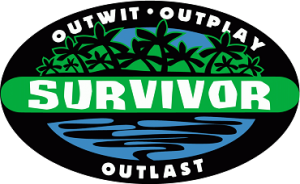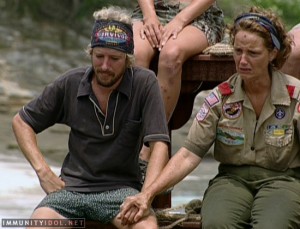I have been watching Survivor for more than half of my life. In 7th grade, I decorated my 3-ring binder with a stalkerish collage of “Boston” Rob Mariano pictures, and several years later my parents indulged me with my first Survivor buff for Christmas. I still own two of my favorite seasons on DVD, as well as my precious Survivor hat and t-shirt. Some would call me a dedicated fan; others, insane.
I love Survivor. And as much as I’d like to think I’m somehow special for my 29 seasons of unwavering loyalty, I’m hardly an anomaly. Fifteen years after its premiere, Survivor continues to attract millions and millions of viewers, many of whom are self-professed superfans. Despite semi-recycled challenges and some predictable casting clichés, Survivor also remains a fixture of CBS’ primetime programming, entering its 30th season this February.
So, what does this have to do with psychology? Over the course of my viewership, I’ve tried to make sense of why Survivor has been such a hit. What makes this show so interesting? Though I can’t say I’ve developed a definitive theory of Survivor’s success, here I’ll point out a few observations about the show as they relate to psychological concepts.
For starters, at its core Survivor is a social experiment. In the premiere episode of Survivor back in 2000, Jeff tells the audience: “Sixteen strangers [will be] forced to band together, carve out a new existence, totally accountable for their actions—they must learn to adapt or they’ll be voted off.” For the last one standing? One million dollars. That is, the show not only provides us a window into the creation of a new mirco-society, but also asks what happens when a group of strangers must strike a balance between collaboration (e.g., to find food, build shelter, create alliances) and competition (to win the big money). For someone like myself who has strong interests in human social behavior as well as a reality TV addiction, this is about as good as it gets.
Interestingly, Survivor is not the first time a group of strangers were placed in a novel environment, split into ‘tribes’, and observed across their interactions. About 40 years before the age of Jeff Probst and reality television, a social psychologist named Muzafer Sherif conducted what is now regarded as a landmark psychological experiment. Sherif sought to better understand intergroup relations by bringing together total strangers and asking them to participate in both collaborative and competitive activities. Specifically, 24 young boys (age 12) were brought to a camp and divided into two groups. The groups were kept entirely separate, and first participated in a series of team-building activities. Within several days of these collaborative exercises, a sense of ‘team spirit’ emerged and status hierarchies within the groups developed. Next, the two groups were brought together to compete each other for prizes, which provoked a strong sense of hostility between the teams. Only in the final stage of the study, when the researchers brought the two teams together to reach a set of superordinate goals (e.g., fixing the camp water faucet), did a sense of intergroup harmony arise.
This study, known famously as the “Robbers Cave Experiment”, offered important insight into the social conditions necessary to provoke intergroup conflict vs. cooperation, and what happens when individuals vie for scarce resources. While there are a number of clear discrepancies between the setup of this study and the format of Survivor, it nonetheless provides an interesting lens through which to understand the TV show and competition for one million dollars. On Survivor, we watch total strangers in constant flux between competition and collaboration. In the early stages of the game, when contestants are divided into two tribes, they must work together to build shelter, find food, and most importantly, win challenges. However, with every challenge lost, the tribe decides who they want to send home—who is the weakest link, or the biggest threat? The same team that was working together to win a challenge four hours earlier now sits in tribal council, forced to vote out one of their own. Similarly, when the two tribes merge about halfway into the season, we watch individuals struggle with the decision to either remain loyal to their prior tribe teammates or abandon their prior group identity and seek out new allies from the (previously) opposing tribe. These types of decisions create a very unstable social landscape, part of what fuels the intrigue of Survivor.
Watching Survivor also offers opportunities for social comparison and reflection, especially when it comes to morals and ethics. Is it okay to lie in the context of a game? What makes a winner—someone who lies and manipulates to make it to the end, or the player who remained loyal to his/her alliance throughout the game? Ethical dilemmas of this sort also keep viewers asking, “What would I do?” One of the most extreme (and contentious) examples of this from Survivor history occurred in Season 7, when Jonny “Fairplay” Dalton told what Jeff Probst would later call “the greatest lie in Survivor history.” At a reward challenge where friends and family were brought to the island, Jonny coordinated an elaborate lie (full video here) that his grandmother had died while he was gone, and that winning the challenge would allow him to spend time with his good friend and receive more information about her passing. His feigned emotional speech brought multiple tribe members to tears and won him the reward. Moreover, it created a heated debate among viewers: was Jonny Fairplay’s lie right or wrong, in the context of the game?
Within the field of psychology, moral behavior has typically been defined as following the rules present in a given context, which can vary considerably across cultures and different social environments. In the game of Survivor, the ‘rules’ get a bit murky, and oftentimes judgments about ‘right’ and ‘wrong’ are largely guided by the preexisting personal ethics of each player and viewer. If the definition of ‘moral behavior’ is truly context-dependent, one could argue that crafting elaborate lies on Survivor to make it further in the game is acceptable—it serves a purpose within the confines of a competitive game. Alternatively, if we believe that certain moral principles should be upheld, regardless of context, Jonny Fairplay’s behavior could be considered morally reprehensible. In discussing Fairplay’s move, Probst stated “It was brilliant from a strategy [point of view] and horrifying on a basic human level.” Survivor provides us a glimpse into a world with an ambiguous ethical code—where moral behavior may not be as clear cut as ‘right’ and ‘wrong’, but situated on some sort of continuum.
So, have I written this intellectualized account of Survivor to justify the five hundred plus hours of my life I’ve invested watching Probst and co.? Perhaps that’s part of it. But in an age of shows like Toddlers in Tiaras and Mob Wives, it’s easy to forget that Survivor was one of the first reality programs that set in motion this fascination with televised human experiences and psychology.
The tribe has spoken.
References
Harvey, O. J., White, B. J., Hood, W. R., & Sherif, C. W. (1961). Intergroup conflict and cooperation: The Robbers Cave experiment (Vol. 10). Norman, OK: University of Oklahoma Press.
Hogan, R. (1973). Moral conduct and moral character: a psychological perspective. Psychological Bulletin, 79(4), 217.
Sherif, M., Harvey, O. J., White, B. J., Hood, W. R., & Sherif, C. W. (1988). The robbers cave experiment. Intergroup conflict and cooperation.
Turiel, E. (1997). Beyond particular and universal ways: Contexts for morality.New Directions for Child and Adolescent Development, 1997(76), 87-105.

